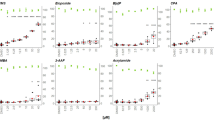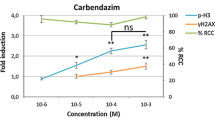Abstract
So far, the majority of in vitro toxicological experiments are conducted after an acute 24 h treatment that does not represent a realistic human chemical exposure. Recently, new in vitro approaches have been proposed to study the chemical toxicological effect over several days in order to be more predictive of a representative exposure scenario. In this study, we investigated the genotoxic potential of chemicals (direct or bioactived clastogen, aneugen and apoptotic inducer) with the γH2AX and pH3 biomarkers, in the human liver-derived HepaRP cell line. We used different treatment durations, with or without a three-day recovery stage (release period), before genotoxicity measurement. Data were analysed with the Benchmark Dose approach. We observed that the detection of clastogenic compounds (notably for DNA damaging agents) was more sensitive after three days of repeated treatment compared to one or three treatments over 24 h. In contrast, aneugenic chemicals were detected as genotoxic in a similar manner whether after a 24 h exposure or a three-day repeated treatment. Globally, the release period decreases the genotoxicity measurement substantially. For DNA damaging agents, after high concentration treatments, γH2AX induction was always observed after a three-day release period. In contrast, for DNA topoisomerase inhibitors, no effect could be observed after the release period. In conclusion, in the HepaRP cell line, there are some important differences between a one-day acute and a three-day repeated treatment protocol, indicating that different cell treatment procedures may differentiate chemical genotoxic mechanisms of action more efficiently.








Similar content being viewed by others
Data availability
Not applicable.
References
Aninat C, Piton A, Glaise D et al (2006) Expression of cytochromes P450, conjugating enzymes and nuclear receptors in human hepatoma HepaRG cells. Drug Metab Dispos Biol Fate Chem 34:75–83. https://doi.org/10.1124/dmd.105.006759
Baldwin EL, Osheroff N (2005) Etoposide, topoisomerase II and cancer. Curr Med Chem Anti-Cancer Agents 5:363–372. https://doi.org/10.2174/1568011054222364
Banerjee T, Chakravarti D (2011) A peek into the complex realm of histone phosphorylation. Mol Cell Biol 31:4858–4873. https://doi.org/10.1128/MCB.05631-11
Barsouk A, Thandra KC, Saginala K et al (2021) Chemical risk factors of primary liver cancer: an update. Hepatic Med Evid Res 12:179–188. https://doi.org/10.2147/HMER.S278070
Beal MA, Audebert M, Barton-Maclaren T et al (2023) Quantitative in vitro to in vivo extrapolation of genotoxicity data provides protective estimates of in vivo dose. Environ Mol Mutagen 64:105–122. https://doi.org/10.1002/em.22521
Bell CC, Lauschke VM, Vorrink SU et al (2017) Transcriptional, functional, and mechanistic comparisons of stem cell-derived hepatocytes, HepaRG cells, and three-dimensional human hepatocyte spheroids as predictive in vitro systems for drug-induced liver injury. Drug Metab Dispos Biol Fate Chem 45:419–429. https://doi.org/10.1124/dmd.116.074369
Bernacki DT, Bryce SM, Bemis JC, Dertinger SD (2019) Aneugen molecular mechanism assay: proof-of-concept with 27 reference chemicals. Toxicol Sci 170:382–393. https://doi.org/10.1093/toxsci/kfz123
Bernadotte A, Mikhelson VM, Spivak IM (2016) Markers of cellular senescence: telomere shortening as a marker of cellular senescence. Aging 8:3–11. https://doi.org/10.18632/aging.100871
Bonner WM, Redon CE, Dickey JS et al (2008) GammaH2AX and cancer. Nat Rev Cancer 8:957–967. https://doi.org/10.1038/nrc2523
Brun C, Allain C, Ferron P-J et al (2023) Extended lifespan and improved genome stability in HepaRG-derived cell lines through reprogramming by high-density stress. Proc Natl Acad Sci 120:e2219298120. https://doi.org/10.1073/pnas.2219298120
Brüsehafer K, Rees BJ, Manshian BB et al (2014) Chromosome breakage induced by the genotoxic agents mitomycin C and cytosine arabinoside is concentration and p53 dependent. Toxicol Sci off J Soc Toxicol 140:94–102. https://doi.org/10.1093/toxsci/kfu058
Burma S, Chen BP, Murphy M et al (2001) ATM phosphorylates histone H2AX in response to DNA double-strand breaks. J Biol Chem 276:42462–42467. https://doi.org/10.1074/jbc.C100466200
Cerec V, Glaise D, Garnier D et al (2007) Transdifferentiation of hepatocyte-like cells from the human hepatoma HepaRG cell line through bipotent progenitor. Hepatol Baltim Md 45:957–967. https://doi.org/10.1002/hep.21536
Committee ES, Hardy A, Benford D et al (2017) Update: use of the benchmark dose approach in risk assessment. EFSA J 15:e04658. https://doi.org/10.2903/j.efsa.2017.4658
Di Micco R, Krizhanovsky V, Baker D, d’Adda di Fagagna F (2021) Cellular senescence in ageing: from mechanisms to therapeutic opportunities. Nat Rev Mol Cell Biol 22:75–95. https://doi.org/10.1038/s41580-020-00314-w
Duivenvoorde LPM, Louisse J, Pinckaers NET et al (2021) Comparison of gene expression and biotransformation activity of HepaRG cells under static and dynamic culture conditions. Sci Rep 11:10327. https://doi.org/10.1038/s41598-021-89710-6
Dural E, Shah U-K, Pritchard D et al (2020) The effect of chronic dosing and p53 status on the genotoxicity of pro-oxidant chemicals in vitro. Mutagenesis 35:479–489. https://doi.org/10.1093/mutage/geaa024
Friedberg EC (2003) DNA damage and repair. Nature 421:436–440. https://doi.org/10.1038/nature01408
Guillouzo A, Corlu A, Aninat C et al (2007) The human hepatoma HepaRG cells: a highly differentiated model for studies of liver metabolism and toxicity of xenobiotics. Chem Biol Interact 168:66–73. https://doi.org/10.1016/j.cbi.2006.12.003
Gupta R, Schrooders Y, Hauser D et al (2021) Comparing in vitro human liver models to in vivo human liver using RNA-Seq. Arch Toxicol 95:573–589. https://doi.org/10.1007/s00204-020-02937-6
Jennen DGJ, Magkoufopoulou C, Ketelslegers HB et al (2010) Comparison of HepG2 and HepaRG by whole-genome gene expression analysis for the purpose of chemical hazard identification. Toxicol Sci off J Soc Toxicol 115:66–79. https://doi.org/10.1093/toxsci/kfq026
Jordan MA, Wilson L (1998) Microtubules and actin filaments: dynamic targets for cancer chemotherapy. Curr Opin Cell Biol 10:123–130. https://doi.org/10.1016/s0955-0674(98)80095-1
Khoury L, Zalko D, Audebert M (2016a) Evaluation of four human cell lines with distinct biotransformation properties for genotoxic screening. Mutagenesis 31:83–96. https://doi.org/10.1093/mutage/gev058
Khoury L, Zalko D, Audebert M (2020) Evaluation of the genotoxic potential of apoptosis inducers with the γH2AX assay in human cells. Mutat Res Genet Toxicol Environ Mutagen 852:503165. https://doi.org/10.1016/j.mrgentox.2020.503165
Khoury L, Zalko D, Audebert M (2016b) Complementarity of phosphorylated histones H2AX and H3 quantification in different cell lines for genotoxicity screening. Arch Toxicol. https://doi.org/10.1007/s00204-015-1599-1
Kim SH, Kwon D-Y, Kwak J-H et al (2018) Tunicamycin-induced ER stress is accompanied with oxidative stress via abrogation of sulfur amino acids metabolism in the liver. Int J Mol Sci 19:4114. https://doi.org/10.3390/ijms19124114
Kopp B, Khoury L, Audebert M (2019) Validation of the γH2AX biomarker for genotoxicity assessment: a review. Arch Toxicol 93:2103–2114. https://doi.org/10.1007/s00204-019-02511-9
Kopp B, Le Hégarat L, Audebert M (2020) Differential toxic effects of food contaminant mixtures in HepaRG cells after single or repeated treatments. Mutat Res Genet Toxicol Environ Mutagen 850–851:503161. https://doi.org/10.1016/j.mrgentox.2020.503161
Parry JM, Parry EM, Boumer R et al (1996) The detection and evaluation of aneugenic chemicals. Mutat Res Mol Mech Mutagen 353:11–46. https://doi.org/10.1016/0027-5107(95)00242-1
Pommier Y (2006) Topoisomerase I inhibitors: camptothecins and beyond. Nat Rev Cancer 6:789–802. https://doi.org/10.1038/nrc1977
Pospelova TV, Demidenko ZN, Bukreeva EI et al (2009) Pseudo-DNA damage response in senescent cells. Cell Cycle Georget Tex 8:4112–4118. https://doi.org/10.4161/cc.8.24.10215
Quesnot N, Rondel K, Audebert M et al (2016) Evaluation of genotoxicity using automated detection of γH2AX in metabolically competent HepaRG cells. Mutagenesis 31:43–50. https://doi.org/10.1093/mutage/gev059
Rumgay H, Arnold M, Ferlay J et al (2022) Global burden of primary liver cancer in 2020 and predictions to 2040. J Hepatol 77:1598–1606. https://doi.org/10.1016/j.jhep.2022.08.021
Sanders J, Thienpont A, Anthonissen R et al (2022) Impact of experimental design factors on the potency of genotoxicants in in vitro tests. Mutagenesis 37:248–258. https://doi.org/10.1093/mutage/geac025
Shah U-K, Seager AL, Fowler P et al (2016) A comparison of the genotoxicity of benzo[a]pyrene in four cell lines with differing metabolic capacity. Mutat Res Genet Toxicol Environ Mutagen 808:8–19. https://doi.org/10.1016/j.mrgentox.2016.06.009
Srinivasan A, King RD, Muggleton SH, Sternberg MJE (1997) The predictive toxicology evaluation challenge. In: Proceedings of the 15th international joint conference on Artifical intelligence - vol 1. Morgan Kaufmann Publishers Inc., San Francisco, pp 4–9
ter Braak B, Niemeijer M, Wolters L et al (2022) Towards an advanced testing strategy for genotoxicity using image-based 2D and 3D HepG2 DNA damage response fluorescent protein reporters. Mutagenesis 37:130–142. https://doi.org/10.1093/mutage/geab031
Theumer MG, Henneb Y, Khoury L et al (2018) Genotoxicity of aflatoxins and their precursors in human cells. Toxicol Lett 287:100–107. https://doi.org/10.1016/j.toxlet.2018.02.007
Vogel EW, Nivard MJ (1993) Performance of 181 chemicals in a Drosophila assay predominantly monitoring interchromosomal mitotic recombination. Mutagenesis 8:57–81. https://doi.org/10.1093/mutage/8.1.57
Wheeldon RP, Bernacki DT, Dertinger SD et al (2020) Benchmark dose analysis of DNA damage biomarker responses provides compound potency and adverse outcome pathway information for the topoisomerase II inhibitor class of compounds. Environ Mol Mutagen 61:396–407. https://doi.org/10.1002/em.22360
Wills JW, Johnson GE, Doak SH et al (2016) Empirical analysis of BMD metrics in genetic toxicology part I: in vitro analyses to provide robust potency rankings and support MOA determinations. Mutagenesis 31:255–263. https://doi.org/10.1093/mutage/gev085
Zhang M, Serna-Salas S, Damba T et al (2021) Hepatic stellate cell senescence in liver fibrosis: characteristics, mechanisms and perspectives. Mech Ageing Dev 199:111572. https://doi.org/10.1016/j.mad.2021.111572
Acknowledgements
We acknowledge Biopredic for the use of the HepaRP cell line and specific cell culture media. The authors acknowledge Juliette Cooke for English editing of the manuscript. This work was in part supported by the Genoshift project (ANR-20-CE34-0016).
Author information
Authors and Affiliations
Contributions
CR performed all of the experiments, data analysis and interpretation through discussions with GM and MA. The first draft of the manuscript was written by CR. All the authors discussed the results and contributed to manuscript edition.
Corresponding author
Ethics declarations
Conflict of interest
The authors declare no competing interests.
Additional information
Publisher's Note
Springer Nature remains neutral with regard to jurisdictional claims in published maps and institutional affiliations.
Supplementary Information
Below is the link to the electronic supplementary material.
Rights and permissions
Springer Nature or its licensor (e.g. a society or other partner) holds exclusive rights to this article under a publishing agreement with the author(s) or other rightsholder(s); author self-archiving of the accepted manuscript version of this article is solely governed by the terms of such publishing agreement and applicable law.
About this article
Cite this article
Recoules, C., Mirey, G. & Audebert, M. Effect of cell treatment procedures on in vitro genotoxicity assessment. Arch Toxicol 98, 1225–1236 (2024). https://doi.org/10.1007/s00204-024-03690-w
Received:
Accepted:
Published:
Issue Date:
DOI: https://doi.org/10.1007/s00204-024-03690-w




